Trees: Birch
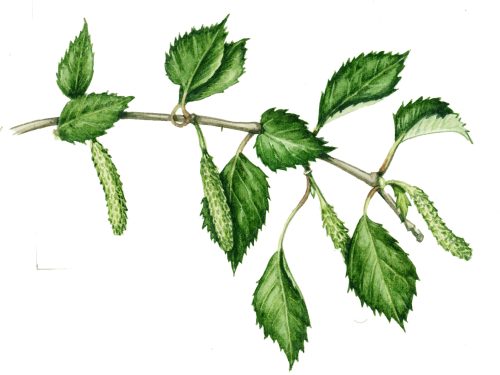
Birch trees: The Silver and the Downy Birch
There are two main Birch trees in the UK, the Silver birch Betula pendula and the Downy birch Betula pubescens. The Downy birch tends to grow better in wetter areas and in the north. The Silver birch likes drier soils and is often found growing ornamentally in gardens and cities.
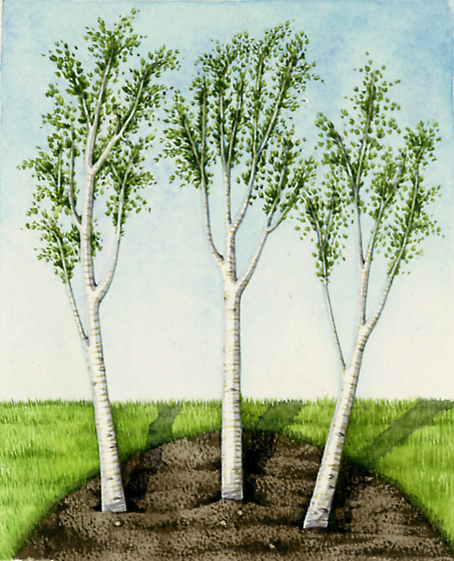
Both reach heights of 30m and can have a 20m spread.
They are pioneer species, easy to recognise, represent guardianship and fertility, and they are used to make everything from shoes to bobbins. Birch also treats ailments as diverse as gout and skin disorders.
Birch trees support over 300 insect species, and birch woodland provides a wonderful habitat for woodland flowers.
This is one of a series of blogs I’m writing on common British trees. You can also see blogs on the Elder, the Yew, the Ash, the Oak, the Holly, the Sycamore, the Rowan, the Beech, and the Hawthorn.
Identification: Tree shape
Birches have a slender shape, and twigs which can droop.
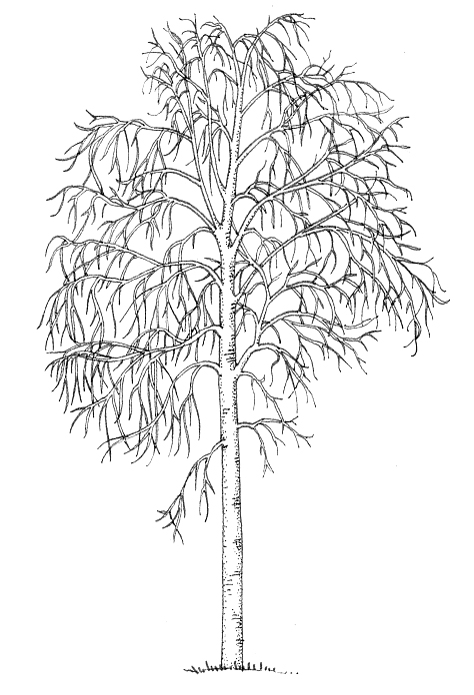
They are often the first to colonize a landscape which has been devastated by fire or deforestation. When it comes to re-wilding, scrubby birch wood is often the first step. This makes them pioneer species, settling the land and making it accessible to other plant species.
Birch is the commonest tree in Scotland, and the Downy birch stretches way up into the arctic. For more on trees growing in such inhospitable climates, check out my blog on illustrating The Treeline by Ben Rawlence.
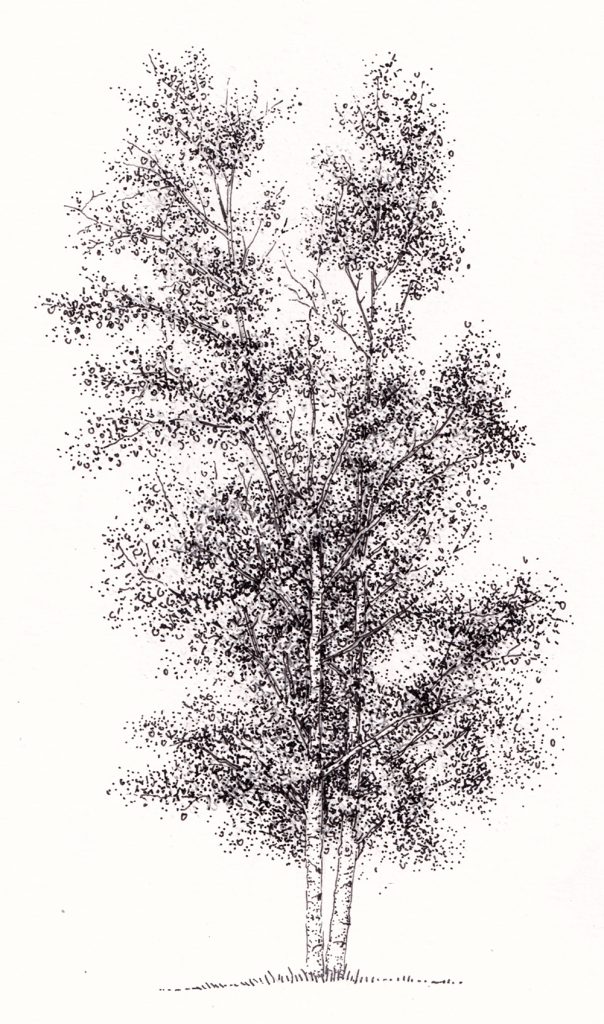
Identification: Leaves
Leaves are more or less triangles, with toothed margins. Each leaf is up to 6cm long, and shiny green. In autumn they turn to a bright, pale yellow.
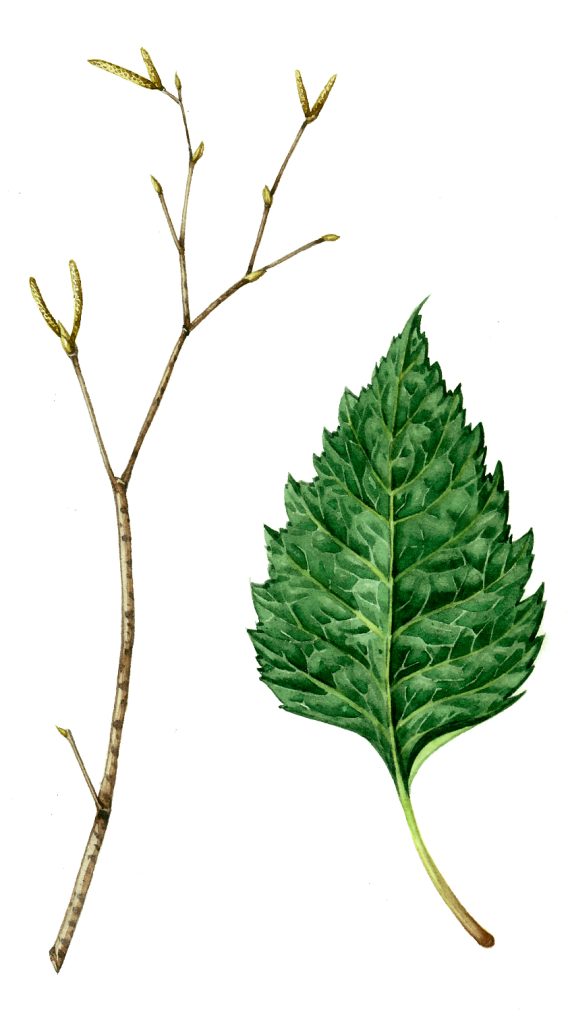
Downy birch have less jagged margin teeth than the Silver birch, and the leaves are diamond-shaped, and less rounded. However, the two birches frequently hybridize, hence me popping them into the same blog.
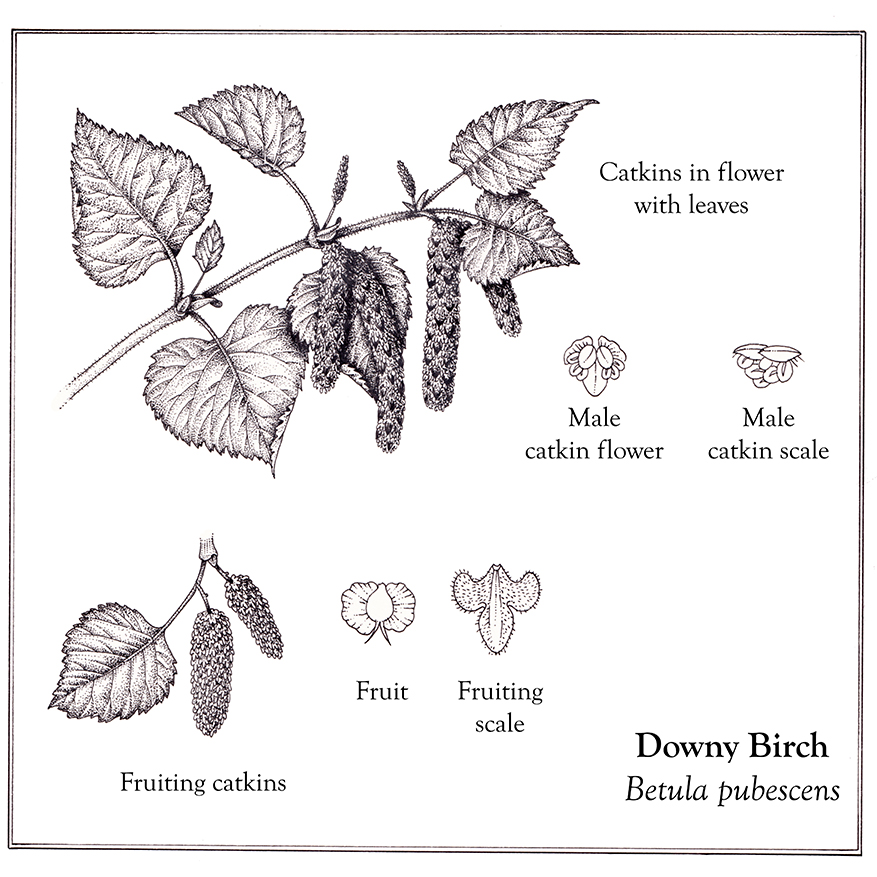
Identification: Flowers
The birch is monoecious, which means it carries male and female flowers on the same plant. These are wind pollinated catkins. Male catkins are yellowish, and grow through the winter maturing as the birch leaves grow in spring, then dropping. These are long catkins, easily visible, and carried in groups of 3 or 4 at the tips of the shoots.
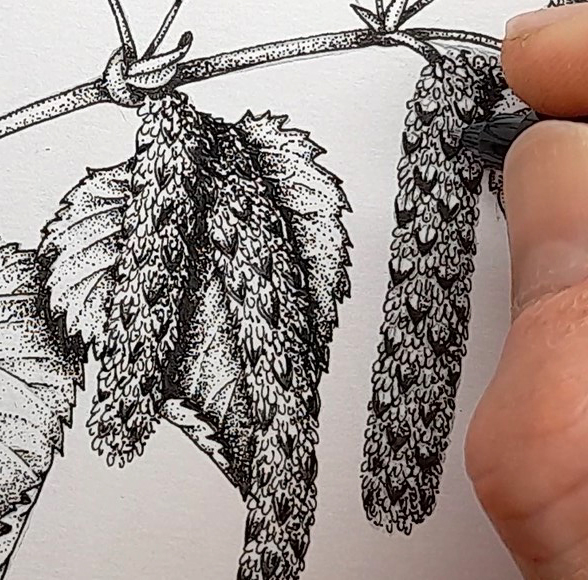
Catkins of the DownyBirch
Female catkins are smaller, and bright green. They’re borne upright and flower in April through May,
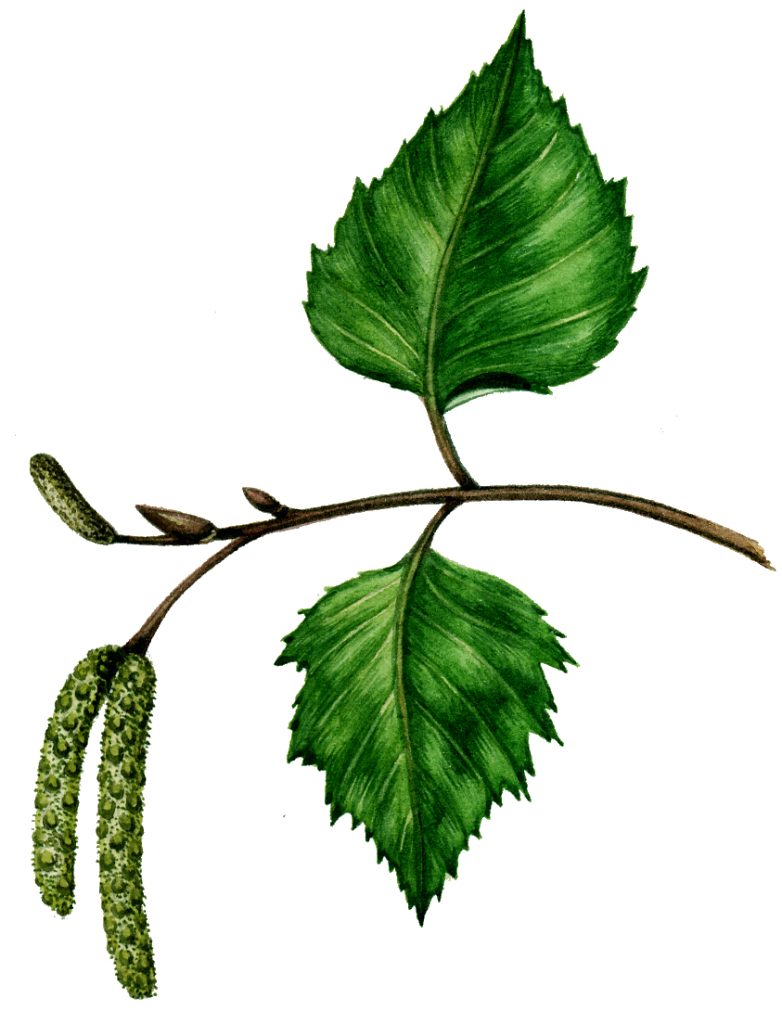
Catkins of the Silver birch
Identification: Fruit
After pollination, the female catkin thickens and develops a dark crimson colour. Masses of tiny seeds are released from this fruit, and borne off in the wind.

Fruiting catkins of the Downy birch
Identification: Bark
Silver birch bark is what gives the tree its name. It’s paper white, and can be peeled from the tree in sheets. There are often dark diamonds present, and older trees may have far darker trunks, especially towards the tree base.
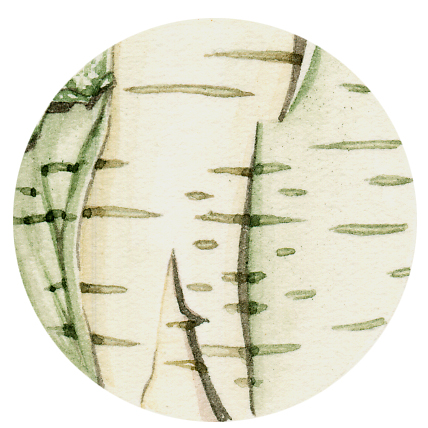
The white colour reflects UV light, some suggest it works like a sunscreen in areas where reflected light from the snow can be blinding.
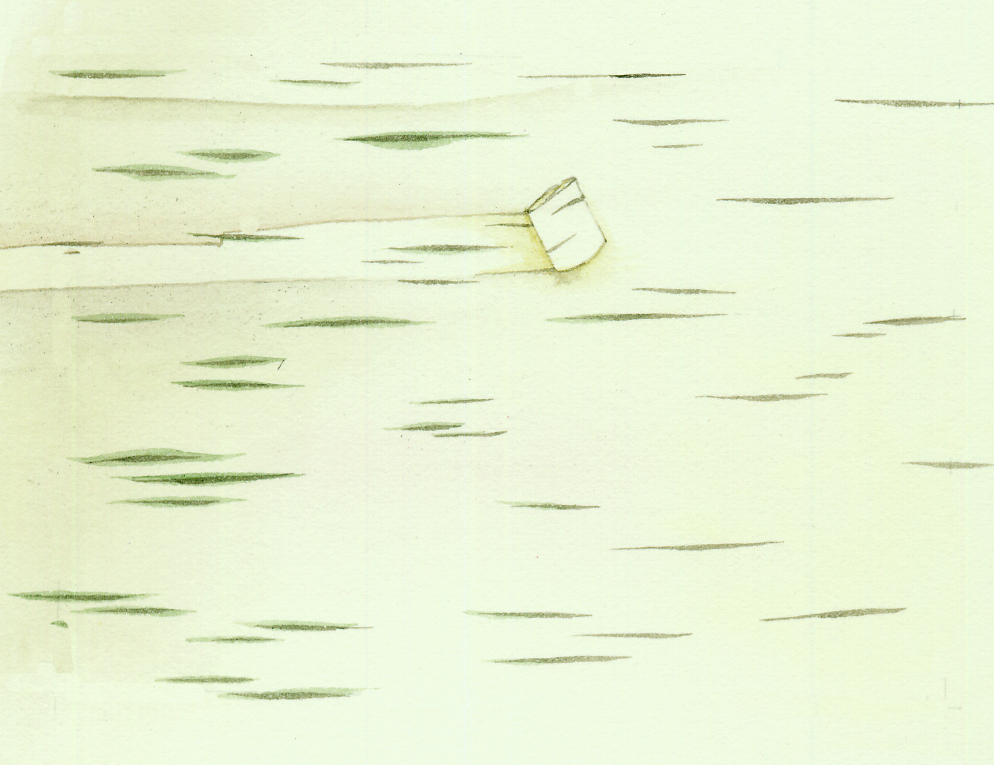
Buds are long, purplish and pointed.
Twigs are drooping and smooth, with dark warts. The shoots of Silver and Downy birch can be used to tell them apart. Silver birch shoots are smooth with warts, whereas those of Downy birch are rough, warty, and covered in short, downy hair.
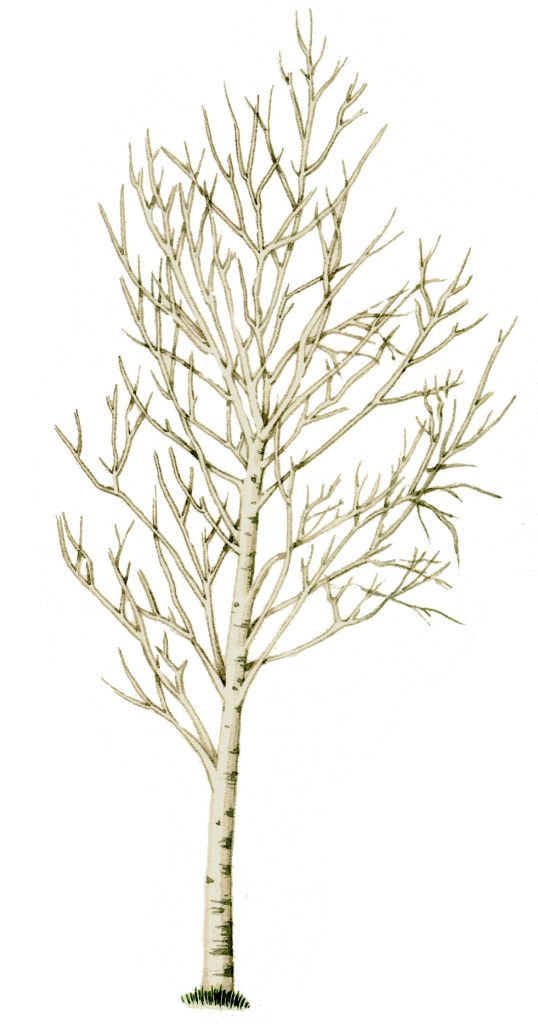
Similar species
The white bark sets these trees apart from others, and the little triangular leaves with their jagged edges are unlike other large tree leaves.
Most sources suggest the main problem here is telling your Downy form your Silver birch, other species don’t get a mention!
History: Folklore
The Birch is seen as a guardian tree, and a way to keep evil spirits at bay.
Baby cradles would be made form birch to keep the devil away, and people would bring bundles of birch wood into their homes at Halloween to repel the evil spirits. Birch brooms swept out dirt, but also got rid of the devil, and a garland of birch twigs might be hung over the door for protection.
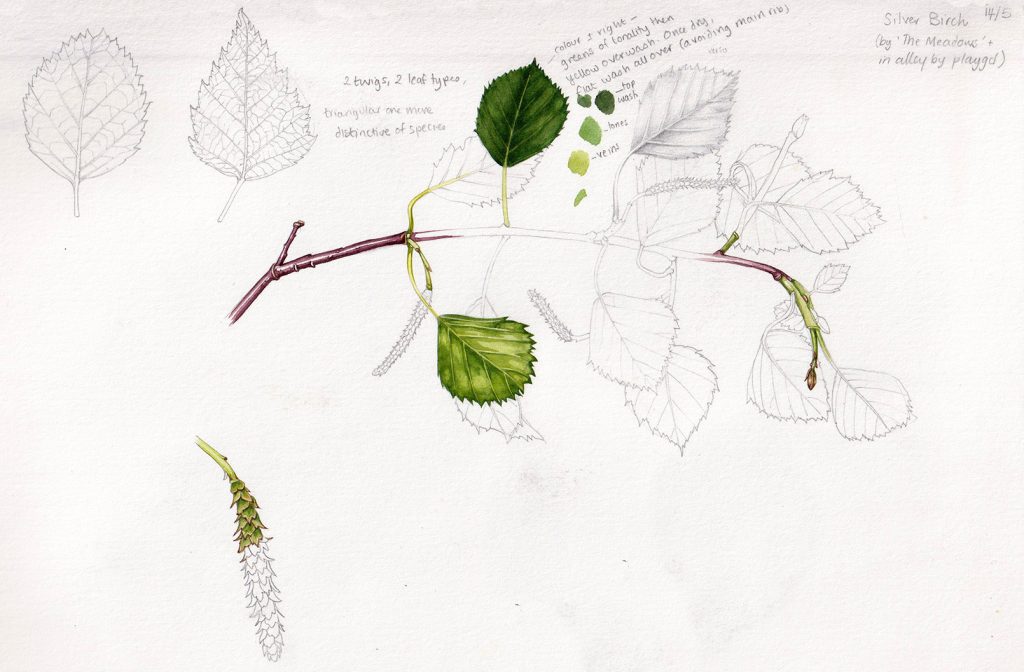
However, witches broomsticks were also meant to be birch wood, so there’s some disconnect there.
Birch is also closely linked to fertility. Using a switch of birch on a heifer would either ensure she got pregnant, or that the calf was healthy.
In Britain, if a couple wished to live together but not marry, they could step over a birch broomstick together. Once done, they could live as man and wife.
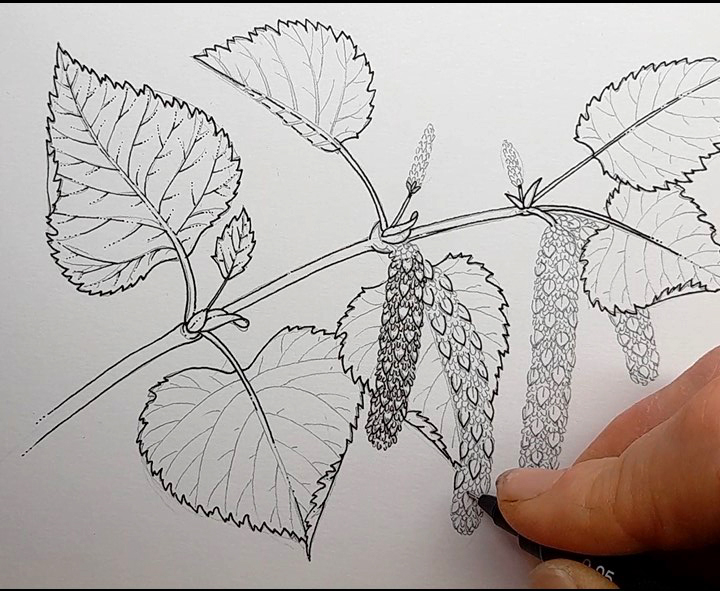
When Beltaine came around on May 1st, with all its’ links to spring and fertility, it would be the Birch tree chosen as the wood for the maypole. In some places, this festival meant any legal bonds between couples could be lifted for 24hrs, and there was frequently a spike in birth-rate at the start of the following February. It will come as no surprise that these practices left the Christian church apoplectic, but powerless to do much about it.
Birch also relates to motherhood and femininity. Russian folklore has the Birch as the “Lady of the Woods”, while there are close links between the Irish goddess Brigid and the Birch. Brigid was the goddess of poetry, something of a muse, and responsible for spinning and weaving.
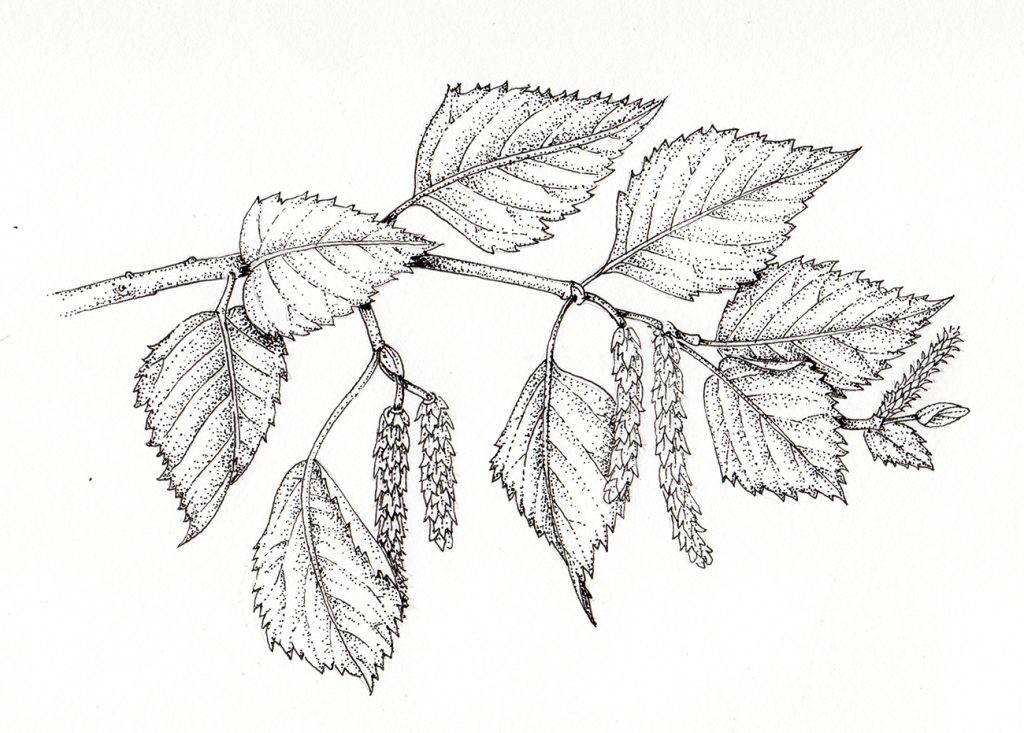
History: Mankind and Birch wood
Birch wood is pale and soft and not very durable. It’s used for walking sticks and broom handles, and makes good charcoal. It also makes good skateboards! Bobbins and spinning reels were made of birch wood, back in the days of the Lancashire Cotton industry.
The bark has been used to make a plethora of things. Sheets of bark were perfect as paper substitutes. Applied to roofs, it provided a level of waterproofing against the rain. You could mould the bark into shoes, or use strips woven together to make baskets for soft fruit.
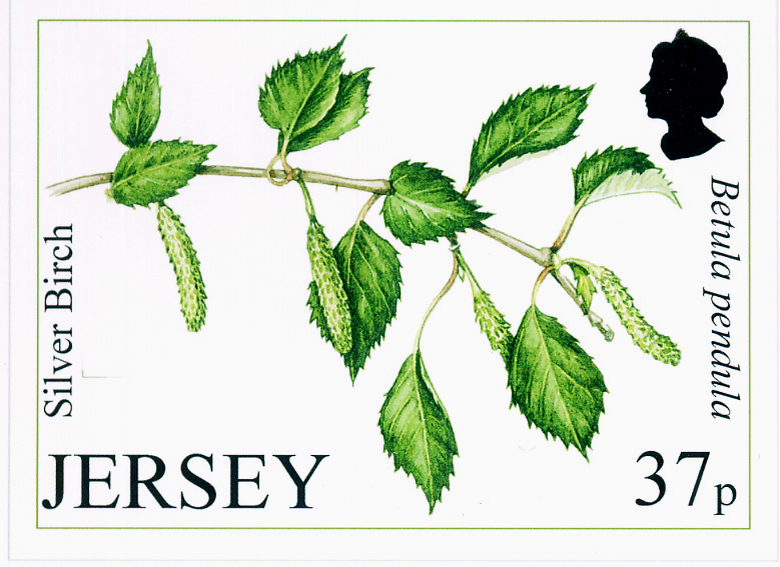
Canoes and boats, hats, firelighters, and rolled bark candles were all made from Birch bark.
Powdered birch helped ensure you had a pale complexion.
Leaves yield a reddish dye, while the catkins provide a sunshine yellow colour.
History: Food and Medicine
The sap of the Birch was gathered and made into wine. This was fed to those afflicted with kidney stones, or urinary tract infections.
Tea made from birch leaves worked on gout and again on kidney stones. The leaves are indeed full of flavonoids, a type of anti-oxidant.
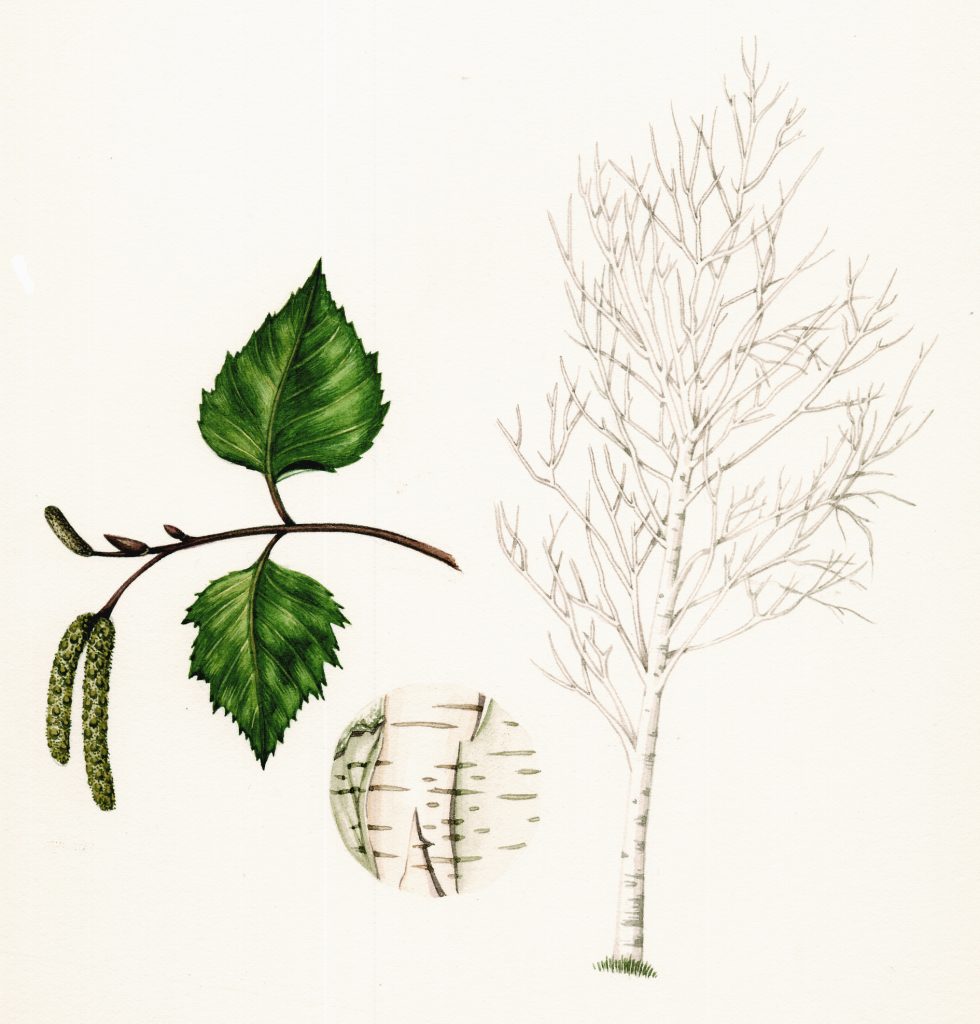
Birch bark oil was used to treat skin disorders like eczema and psoriasis; the same substance was used to waterproof boats.
In the north, after a sauna you can stimulate circulation by beating yourself with a birch stick. And, while we’re on the topic of beating, the dreaded old school cane was often made of birch.
Birch and Wildlife
Birch woodland has a light, airy canopy. This proves excellent for wild flowers like Wood anemone, Violets, Bluebell, and Wood sorrel, as well as for mosses.
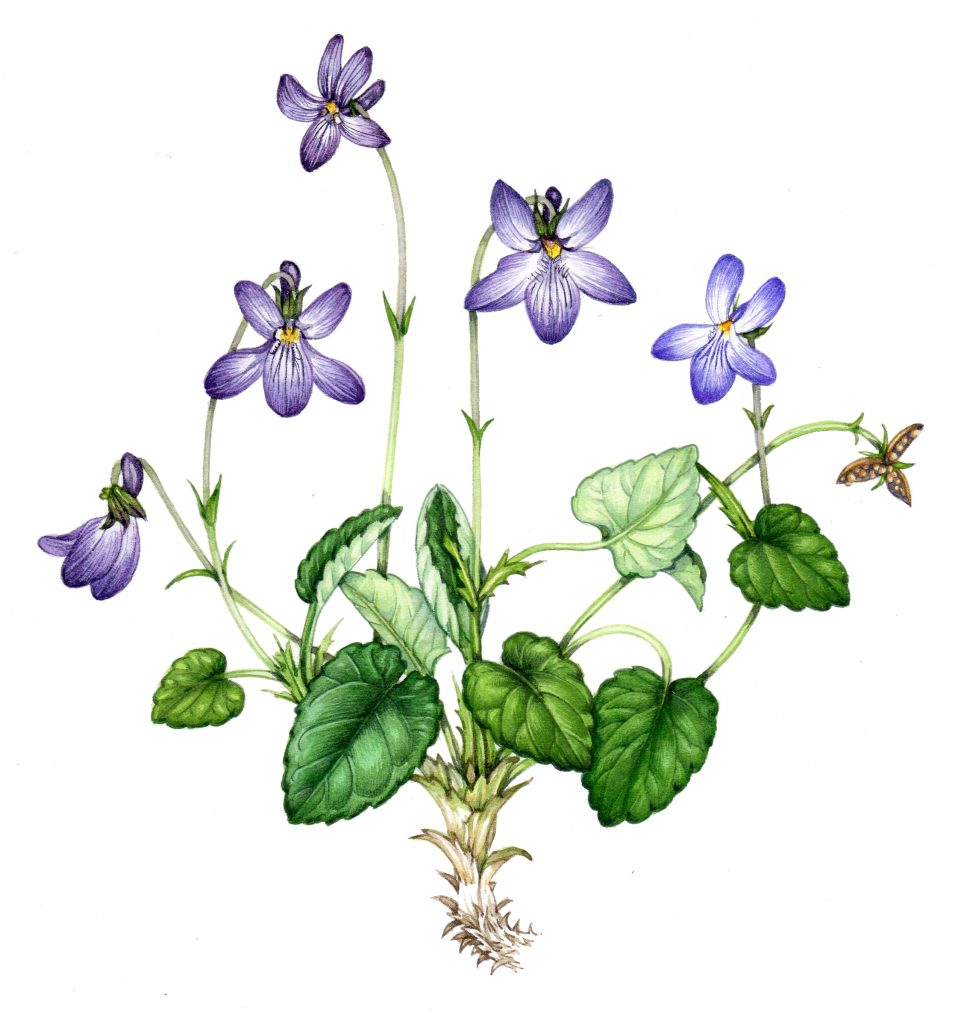
Over 300 insect species are associated with birch, including a lot of aphid species. In turn, this means that Birch trees are great for ladybirds who feast on the aphids. Moths such as Angleshades, Buff tip, and Kentish Glory have Birch as host plant for their caterpillars.
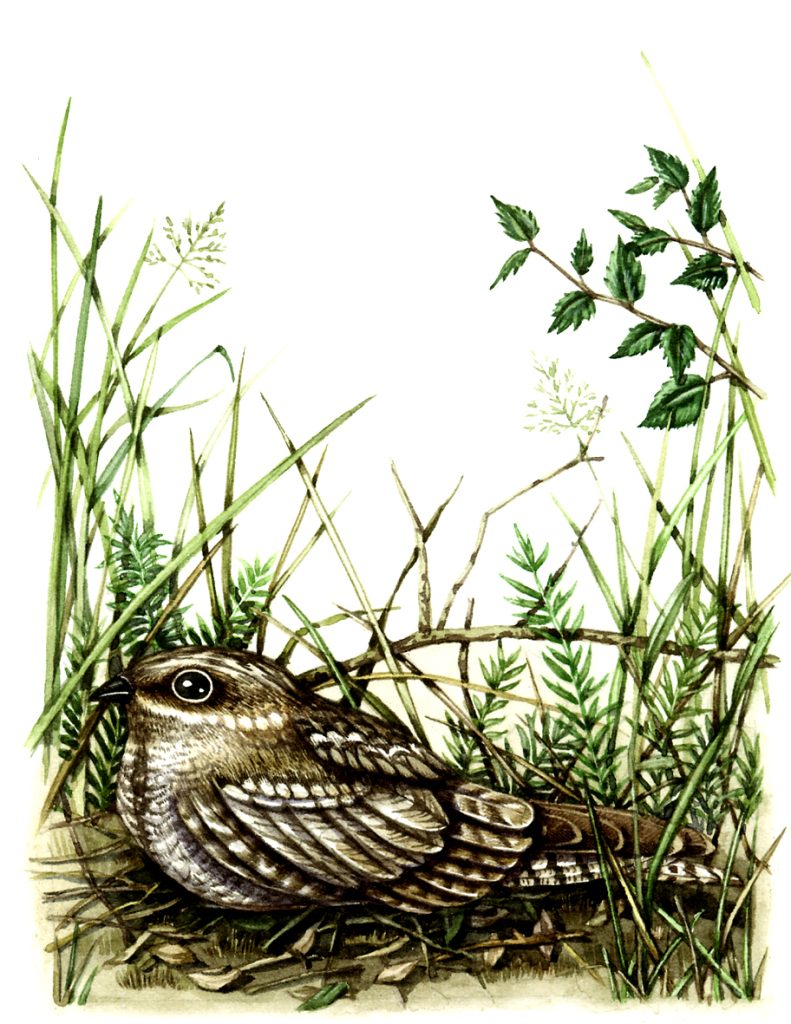
Birds use the birch too; siskin and greenfinch eat the seeds while woodpecker nest in tree cavities.
Fungus are common on the woodland floor with Fly agaric, Woolly milk cap, Chanterelle, and the Birch polypore closely associated with the birch.
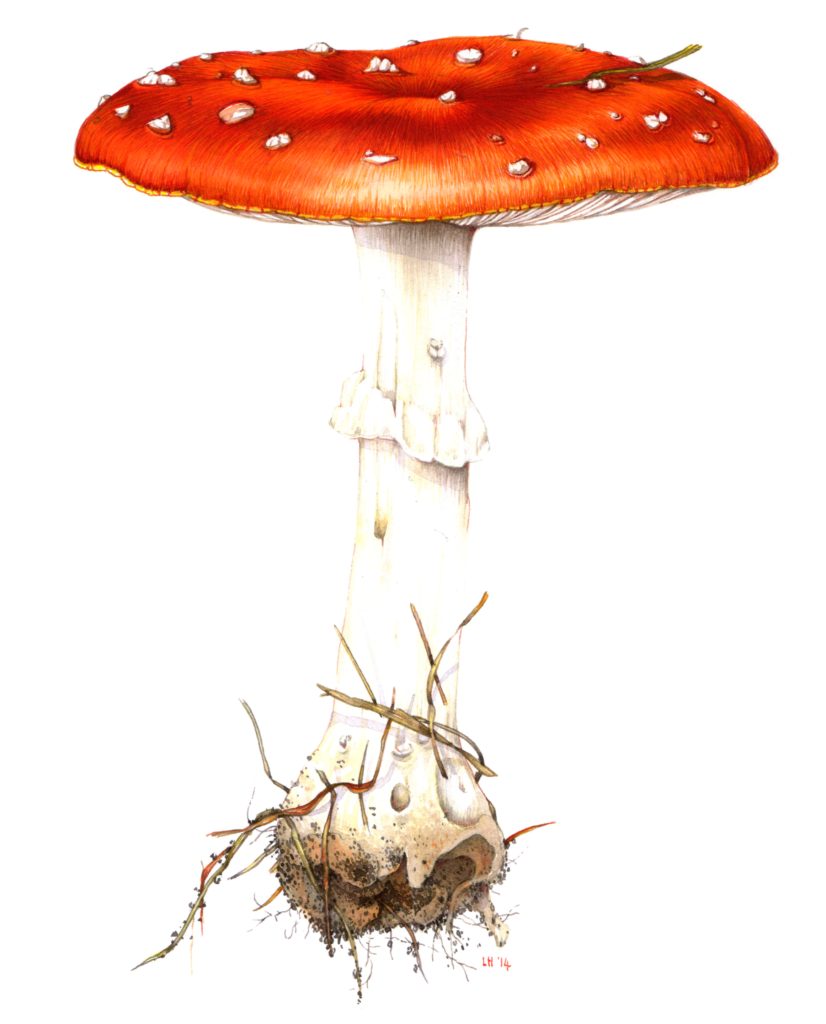
Fly agaric Amanita muscaria
Threats
The threats to Birch in the UK are limited, Plantations can fall prey to Birch dieback, which is caused by two fungal species. However, self-seeded trees seem more immune.
As with every single species, the climate emergency presents challenges to birch trees living very far north. However, it’s probably the Downy birch tree’s incremental growth further and further northward that forms a more immediate ecological threat.
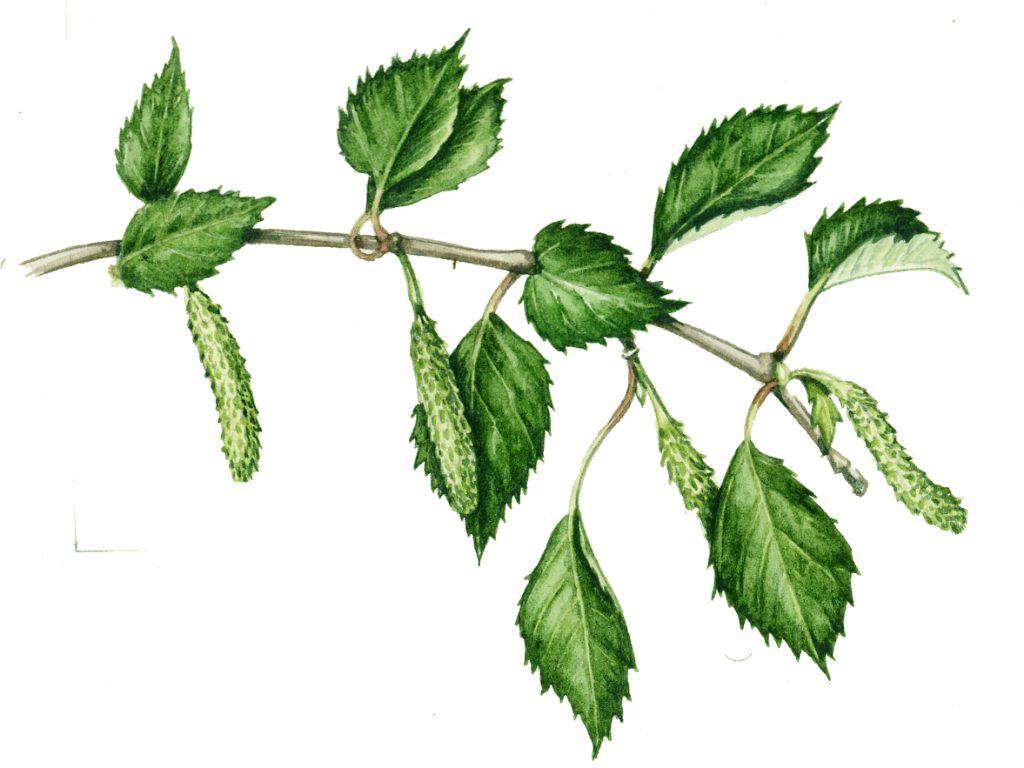
Conclusion
Birch are elegant ornamental trees, instantly recognised thanks to their white bark.
With links to protection and fertility, and the ability to heal skin diseases and be used for building canoes, it’s a fascinating tree.
The most common tree in the whole of Scotland, and stretching across vast swathes of the planet, the Birch is worthy of our respect, and love.
Online sources for this blog include websites of The Woodland Trust, Kew’s Plants of the World, Tree guide UK, Trees for life, and Naturespot. Reference books for this blog include the excellent The Greenwood Trees by Christina Hart-Davies , and the Reader’s Digest The Field Guide to the Trees and Shrubs of Britain (out of print but commonly available second-hand). I also referred to The Tree Forager by Adele Nozedar and The Living Wisdom of Trees by Fred Hageneder.


Hi Lizzie, oh dear more to take in, I am becoming obsessed with this blog…. change the word obsessed to fascinated 👍
Regards Peter
Dear Peter
Obsessed is fine by me. It’s exactly the same for me, as I research my blogs I get more and more tangled up in the incredible things and amazing interractions that nature presents us with. It’s lovely to know you read the blogs, and appreciate them. Thankyou!
Hi Lizzie. Like Peter I am becoming obsessed with reading your interesting blogs but also with learning so much about nature that I was never aware of. I wish I had had this hunger for learning when I was at school. Who knows where it would have taken me. I am 67 now, onward and upward I say! Can’t wait for your next blog. Such a lovely way to learn.
Please can you tell me how to tell the difference between Hazel catkins and Birch catkins at this time of year? There is a broken branch in the ditch that the farmer left behind but no leaves yet. I was going to break a piece off before it dies back.
Hi Christine
Thats a lovely comment, thankyou.
Now, catkins. I can totally see why its easy to confuse Birch and Hazel male catkins (the dangly ones). A good tip might be to look for the female flowers. With Hazel, these look like tiny upright cones with a tuft of scarlet (stigms) at the tip. Birch dont have these, but have upright small green female flowers that look a bit like the long male catkins, but upright not dangling down.. There may also be leaf buds in evidence, those of the Hazel are rounded while the birch has really elegant, pointed and thin leaf buds. Compare these two photos: https://www.woodlandtrust.org.uk/blog/2018/12/which-trees-have-catkins-and-how-to-tell-them-apart/. Then there’s the timing of pollen release. With Hazel, clouds of pale yellow pollen are released before the leaves burst out of their buds. With birch, the male catkins release pollen at the same time as leaf burst. https://www.countryfile.com/wildlife/trees-plants/how-to-identify-catkins/ Hope this helps. I think it’s likely that you’ll have a Hazel rather than a birch, but double check And enjoy painting those catkins, no matter what species they belong to!
Hi Lizzie thank you for the links. I have found some old reference books on trees and will sit down tonight and have a good bimble through them. Mrs Little thinks I am mad but I know better…..
Old books are always an excellent way to spend time. x